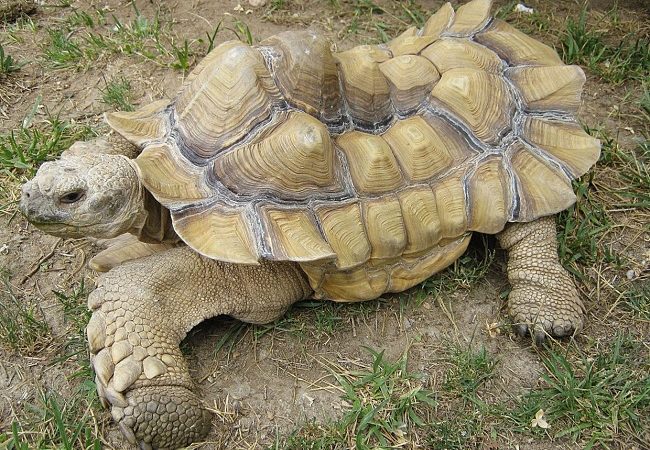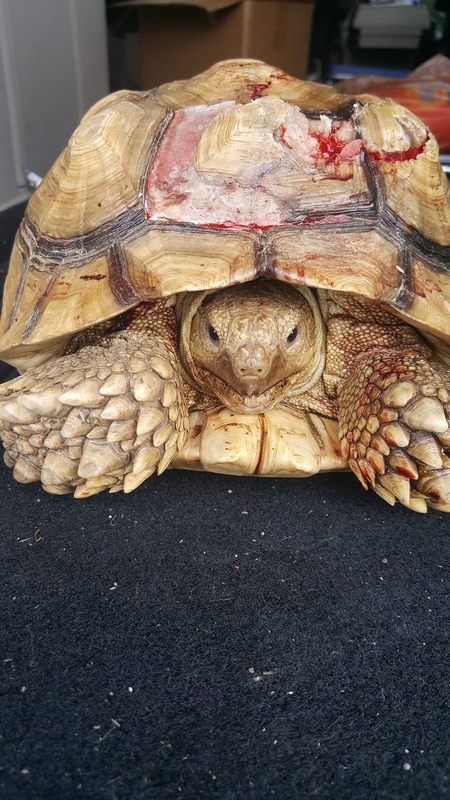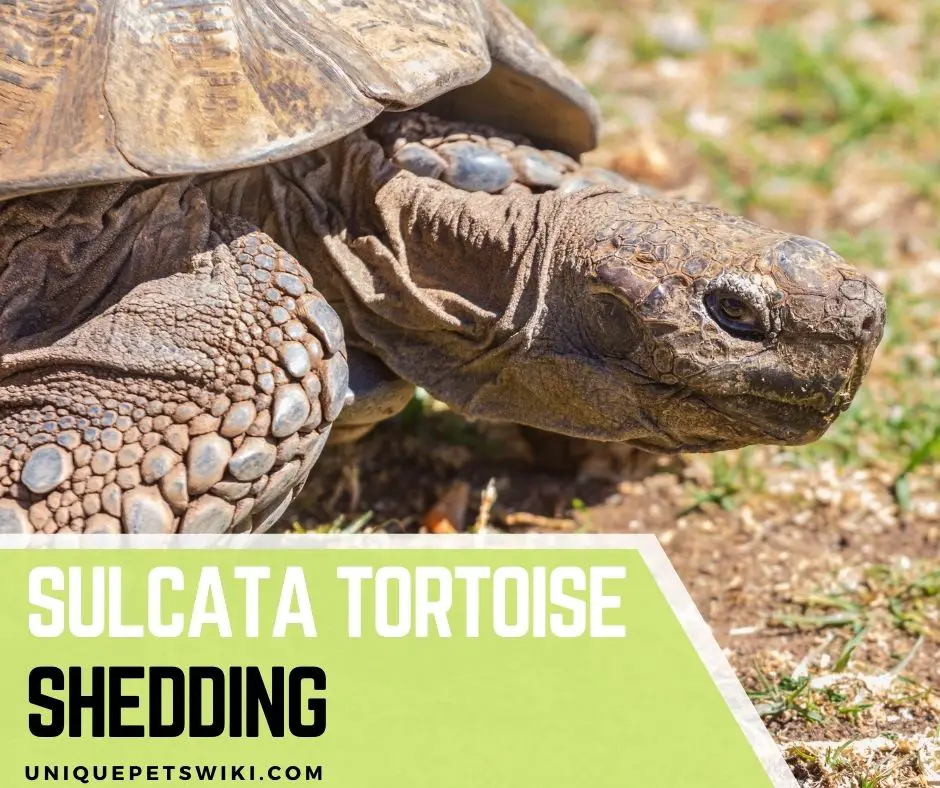Like other reptiles, sulcata tortoises have scaly skin, especially in vulnerable parts of their body, while a shell protects other parts. When it comes to shedding cycles, shedding in sulcata tortoise is not as popular as other reptiles, and you may be wondering if they also shed at all.
Sulcata tortoises do shed their skin, and you will find them shedding their skin and shells regularly. Sulcata tortoise shedding helps them grow new skin and bigger shells and protect their body from disease.
Shedding in sulcata tortoise is a normal process, but several signs can indicate whether it is a healthy shedding and when it is not. In this article, we will help break down everything that you need to know about shedding in sulcata tortoise.
Contents
Do Sulcata Tortoise Shed Skin/Shell?
Just like other reptiles and many animals, sulcata tortoises do shed their skin. Shedding is a normal process for your sulcata tortoise, and they regularly shed their skins and shells when growing up. Sulcata tortoises usually shed their skin in patches and flake on regularly.
Whenever you notice that your tortoise starts to shed their skin, you don’t need to assume that anything is wrong with it. However, when in doubt, it is recommended to visit the vet to help determine whether it is a skin condition or not.

How Often Do Tortoises Shed Skin?
Sulcata tortoises usually shed their skin every few months. Unlike snakes that shed their entire skin in one piece, sulcata tortoise old skin cannot shed their skin in one large piece. This is because they have a hard shell that prevents this.
This means their skin peels off bit by bit, and you don’t need to assume that your tortoise is suffering from a skin disease.
Why Is Your Sulcata Tortoise Shedding?
It is normal for sulcata tortoises to shed their skin and shells. They usually shed their skin as they grow old. During the sulcata tortoise shedding cycle, new and larger scutes are formed under the old ones to grow their shell.
Sulcata tortoises also shed their skin on their legs and necks when growing up. This is because their skin cannot stretch and will not grow unless it sheds away. Apart from natural development, another thing that can make a sulcata tortoise is showing signs of disease.
In the section below, we will highlight the reasons why a sulcata tortoise shed its skin.
Natural And Healthy Causes
It is normal to find juvenile sulcata tortoises that are still growing to shed at some point. Tortoises usually shed their scutes as they grow. They do this to replace the old ones with newer and larger scutes which help to make their shells bigger.
Sulcata tortoises also shed their skin from the head, tail, and legs as they grow. This is because they do not have elastic skin and will need to shed their skin as they grow older. Sulcata tortoises usually shed their skins in patches and flakes regularly and can even take longer than shedding in other reptiles.
You may or may not notice shedding in your tortoise, but it is similar to how humans shed their skin.
Your Sulcata Tortoise Might Be Sick
There are times when your tortoise can start shedding because of a skin condition. Furthermore, shedding in sulcata tortoise can indicate that your tortoise has a nutritional deficiency, liver, kidney, or thyroid disease, or even bone disease.
Some of the factors that can lead to unhealthy shedding in sulcata tortoises are
- Bacterial and fungal infections
- Basking in a hot area
- Overfeeding
- There is a high ammonia level in the tortoise
- Injuries caused by the presence of sharp items in their enclosure.
- Presence of low environmental temperature
Some of the diseases that can make your sulcata tortoise shed are stated below.
Metabolic Bone Disease (MBD)
This is a health condition in tortoises that makes your tortoise bones lose their calcium and then soften the shell or make it malformed. This usually occurs in tortoises that do not get the adequate calcium, UVB rays, and Vitamin D needed for their growth.
One of the symptoms of metabolic bone disease is shedding or peeling of scutes. You can avoid MBD by ensuring you provide your tortoise with ideal nutrition and husbandry. You can also correct MBD through aggressive therapies.
Pyramiding

Source – [Pet Sulcata]
Pyramiding is a health condition in tortoises where your tortoise has an abnormal shape as its scutes form a pyramid shape or raised peak. This usually occurs if you do not provide your tortoise with the appropriate lighting or through chronic malnutrition.
One of the major symptoms of pyramiding is that the scutes will be pushed upwards and will look like a pyramid. During this process, the scutes will become damaged and your tortoise may start to peel or shed. However, shedding during pyramiding is not as common as during MBD.
You can prevent pyramiding in your sulcata tortoise by providing the appropriate lighting, foods, and environments. However, the shape formed will remain for life even once you have corrected it with appropriate husbandry and nutrition.
Shell Rot
Shell rot is an infection on the shell of your sulcata tortoise. This health condition can affect the carapace and the plastron of your tortoise. Shell rots in tortoises can be caused by the bacteria found in dirty environments like dirty water or moldy beddings.
The bacterial will then infect the blood vessels and shell of your tortoise to form a small pit. You can notice this when there are soft spots on your tortoise body. This is why you must keep your sulcata tortoise in a clean environment.
However, a critical shell rot can make your tortoise scutes fall off and expose the bone under them. You can treat shell rot with aggressive antibiotics, and it can take some time before it can heal.

Septicemic Cutaneous Ulcerative Disease (SCUD)
SCUD affects the liver and organs of your tortoise. It is caused by bacteria that enter your tortoise’s bloodstream from the wound on its shell. This serious health condition usually starts as infections on your tortoiseshell through wounds or trauma, plus poor husbandry.
Your tortoise’s scutes may start to peel or shed if there is a wound on their shell. Once you notice any wound or trauma on your tortoise’s body, you should immediately visit an exotic vet for diagnosis.
Injury
Your tortoise may injure themselves when exploring their environment. However, bacteria can infect the area around the injury if it penetrates the skin and leads to swelling. This is why it is important that you regularly check for any signs of localized infection, also called an abscess.
The common places where abscesses in tortoises occur is usually around the skin on the side of their head. Abscess in a tortoise can kill the tortoise if it is not treated because the bacteria will overwork the natural defenses of your tortoise.
Your tortoise’s scutes may start to shed or peel if there is any injury to their shell. You can prevent infection or injury by cleaning the injured area thoroughly. You can also take a swab for an antibiotic culture test to help determine the antibiotic suitable for treating the infection.
How Did The Sulcata Tortoise Shedding Process Happen?
At first, shedding in sulcata tortoises can look strange because they usually shed differently from snakes. Instead of shedding their skin in a single piece, sulcata tortoises will shed their skin in pieces. This shows that the shedding process is quite different, can even take longer, and may not be obvious to the owner.
During the growth process, sulcata tortoise scutes will shed into sections while the other part of the body regrows. This is a natural process, and it means your tortoise is shedding its old shell to form a new one as it grows.
Some of the signs to look out for when your tortoise is shell shedding are stated below.
- The shell will become firmer.
- The older scutes will lose their color and become translucent
- A new layer will develop under their shell
- The shell will grow larger slowly.
- Your tortoise can appear to be more active during the shedding process.
Signs Of A Healthy Sulcata Tortoise Skin And Shell Shedding
Here are some of the signs of healthy skin and shell shedding in sulcata tortoise.
- Once a new layer starts to form underneath, the old tortoise skin will appear duller and look thicker.
- Your tortoise skin will begin to flake off during the shedding process.
- During shell shedding, you will notice a larger and new scute under your tortoise’s old shell.
- Your tortoise will bask more in the sun than usual to help in drying up their old skins and scutes and then fall off.
Note: It is quite normal to find your tortoise eating their scutes once they fall off. However, you should try to help remove the shed scutes from their enclosure for safety precautions. This is because it may damage your sulcata tortoise’s internal organs and throat.
Signs Of An Unhealthy Sulcata Tortoise Shedding
Although shedding is a normal process of tortoise, there are times when the process can be unhealthy, and you need to be concerned. Some of the signs of unhealthy sulcata tortoise shedding are stated below.
- There are rotting or patchiness on your tortoiseshell
- Your tortoise’s scutes are broken
- The shedding cycle in your tortoise is reoccurring at an alarming frequency.

Do You Need To Help A Shedding Sulcata Tortoise?
No, sulcata tortoises don’t usually need help with shedding. This is because shedding is a natural process that they pass through. However, you can provide them with a varied diet, an ideal environment, and access to clean water to make the process less stressful to them.
You can only help your tortoise with shedding if you notice that it becomes too dry. This usually affects skin shedding as the skin may hang on your tortoise’s body instead of falling off. You can then help by spraying your tortoise with a small amount of water or just soak it in a shallow container with some water.
This will help to soften the dead cells, and they will fall off their body gently.
Note: Avoid peeling away the dry skin or scutes from your tortoise body, especially when you cannot pull it easily. You can also help your tortoise to shed by bathing it and gently scrub. This will help to make the shedding process quite faster.
Wrapping Up
It is a normal and healthy process for sulcata tortoises to shed. During the growth process, your sulcata tortoise usually shed their shell and skin to help it grow bigger. Shedding will also help keep your tortoise’s shell young and healthy and prevent infections if your tortoise gets injured.
Furthermore, sulcata tortoises can go through the shedding process on their own, and you don’t have to help them out unless there is a reason for you to do that.
